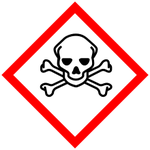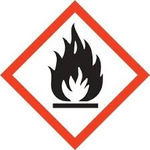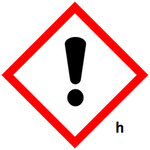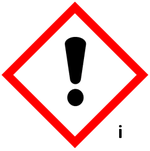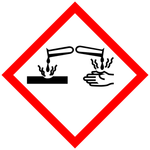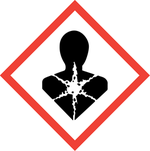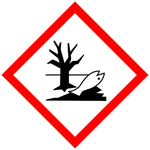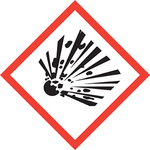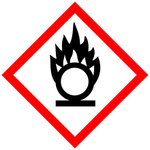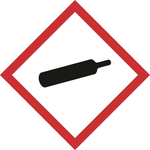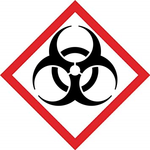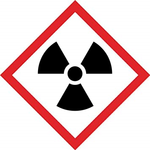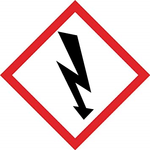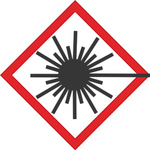Difference between revisions of "Hazard"
(→About Hazards) |
|||
| Line 148: | Line 148: | ||
| style="height:20px; width:150px; text-align:center;" |[[LASER Radiation]] is an extremely [[intensity|intense]] beam of [[light]]. | | style="height:20px; width:150px; text-align:center;" |[[LASER Radiation]] is an extremely [[intensity|intense]] beam of [[light]]. | ||
|} | |} | ||
| + | |||
| + | ===References=== | ||
| + | ====AQA==== | ||
| + | |||
| + | :[https://www.amazon.co.uk/gp/product/1471851370/ref=as_li_tl?ie=UTF8&camp=1634&creative=6738&creativeASIN=1471851370&linkCode=as2&tag=nrjc-21&linkId=01c69b0ae058f809cf636033e6ba793e ''Hazards, page 114, GCSE Physics, Hodder, AQA ''] | ||
| + | :[https://www.amazon.co.uk/gp/product/0198359381/ref=as_li_tl?ie=UTF8&camp=1634&creative=6738&creativeASIN=0198359381&linkCode=as2&tag=nrjc-21&linkId=47c8d1ae58d8b3a5e2094cd447154558 ''Hazards, page 265, GCSE Chemistry; Third Edition, Oxford University Press, AQA ''] | ||
| + | :[https://www.amazon.co.uk/gp/product/019835939X/ref=as_li_tl?ie=UTF8&camp=1634&creative=6738&creativeASIN=019835939X&linkCode=as2&tag=nrjc-21&linkId=57e96876985fc39b1a3d8a3e3dc238b6 ''Hazards, page 278, GCSE Physics; Third Edition, Oxford University Press, AQA ''] | ||
| + | :[https://www.amazon.co.uk/gp/product/1782945563/ref=as_li_tl?ie=UTF8&camp=1634&creative=6738&creativeASIN=1782945563&linkCode=as2&tag=nrjc-21&linkId=9a1d023a374038e6072f33c4f3cf808b ''Hazards, page 3, GCSE Biology; The Revision Guide, CGP, AQA ''] | ||
| + | :[https://www.amazon.co.uk/gp/product/1471851362/ref=as_li_tl?ie=UTF8&camp=1634&creative=6738&creativeASIN=1471851362&linkCode=as2&tag=nrjc-21&linkId=7d78d70a2044ee9982dae010c94af92a ''Hazards, pages 151-2, GCSE Combined Science Trilogy 2, Hodder, AQA ''] | ||
| + | :[https://www.amazon.co.uk/gp/product/1782945571/ref=as_li_tl?ie=UTF8&camp=1634&creative=6738&creativeASIN=1782945571&linkCode=as2&tag=nrjc-21&linkId=9e29fad914244909903e5e93f8a01d153 ''Hazards, pages 4, 108, GCSE Chemistry; The Revision Guide, CGP, AQA ''] | ||
| + | :[https://www.amazon.co.uk/gp/product/1782946403/ref=as_li_tl?ie=UTF8&camp=1634&creative=6738&creativeASIN=1782946403&linkCode=as2&tag=nrjc-21&linkId=32a0abb60dff015b15b50e9b1d7b4644 ''Hazards, pages 6, 7, GCSE Combined Science Trilogy; Physics, CGP, AQA ''] | ||
| + | :[https://www.amazon.co.uk/gp/product/1782945954/ref=as_li_tl?ie=UTF8&camp=1634&creative=6738&creativeASIN=1782945954&linkCode=as2&tag=nrjc-21&linkId=100574c08fbbb64318256eb79ed61a76 ''Hazards, pages 7, 8, GCSE Biology, CGP, AQA ''] | ||
| + | :[https://www.amazon.co.uk/gp/product/1782945962/ref=as_li_tl?ie=UTF8&camp=1634&creative=6738&creativeASIN=1782945962&linkCode=as2&tag=nrjc-21&linkId=476bb5c8d1dfb5c08ac81b6d4d1c98d8 ''Hazards, pages 7, 8, GCSE Chemistry, CGP, AQA ''] | ||
| + | :[https://www.amazon.co.uk/gp/product/1782946381/ref=as_li_tl?ie=UTF8&camp=1634&creative=6738&creativeASIN=1782946381&linkCode=as2&tag=nrjc-21&linkId=5ec5fc3f6429e30c1d9ab9bca2bccf93 ''Hazards, pages 7, 8, GCSE Combined Science Trilogy; Biology, CGP, AQA ''] | ||
| + | :[https://www.amazon.co.uk/gp/product/178294639X/ref=as_li_tl?ie=UTF8&camp=1634&creative=6738&creativeASIN=178294639X&linkCode=as2&tag=nrjc-21&linkId=51599bb45a2bfaf7c1b6a978b2ca2616 ''Hazards, pages 7, 8, GCSE Combined Science Trilogy; Chemistry, CGP, AQA ''] | ||
| + | :[https://www.amazon.co.uk/gp/product/1782945970/ref=as_li_tl?ie=UTF8&camp=1634&creative=6738&creativeASIN=1782945970&linkCode=as2&tag=nrjc-21&linkId=a120d24dcc7cc7a58192069a3aafc1d2 ''Hazards, pages 7, 8, GCSE Physics; The Complete 9-1 Course for AQA, CGP, AQA ''] | ||
Revision as of 14:59, 6 November 2019
Contents
Key Stage 3
Meaning
A hazard is something that could be dangerous.
About Hazards
- Something which is hazardous may be unsafe if used incorrectly.
- When dealing with hazards the danger can be reduced by taking precautions.
Examples
| Toxic | Flammable | Harmful | Irritant |
| A toxic substance is one that is so poisonous it could kill a human. | A flammable substance is one that can catch on fire easily. | A harmful chemical is one that can cause damage to an organism. | An irritant is a substance that can cause itching and pain to the skin, eyes or lungs |
| Corrosive | Long Term Health Risk | Dangerous to the Environment | Explosive |
| A corrosive substance is one which can break down other materials or damage the skin. | Chemicals that are a long term health risk cause non-communicable diseases if they are used repeatedly over long periods of time. | A chemical that is dangerous to the environment can kill organisms other than humans. | An explosive substance is one which can react very quickly, without needing oxygen from the air, that produces a lot of gas during the reaction. |
| Oxidising Agent | Compressed Gas | Biohazard | Ionising Radiation |
| An oxidising agent is a chemical that causes the oxidation of other chemicals. | Compressed Gas is when a gas is held under high pressure in a container. | A biohazard is something which contains pathogens which could cause disease. | Ionising Radiation is radiation which can cause atoms to lose electrons and become ions. |
| Danger of Electrocution | LASER Radiation | ||
| A danger of electrocution is when there is electricity at such a large potential difference that it could pass through a living organism. | LASER Radiation is an extremely intense beam of light. |
Key Stage 4
Meaning
A hazard is something that could cause harm to living organisms.
About Hazards
- Something which is hazardous may be unsafe if used incorrectly.
- When dealing with hazards the danger can be reduced by taking precautions.
Examples
| Toxic | Flammable | Harmful | Irritant |
| A toxic substance is one that is so poisonous it could kill a human. | A flammable substance is one that can catch on fire easily. | A harmful chemical is one that can cause damage to an organism. | An irritant is a substance that can cause itching and pain to the skin, eyes or lungs |
| Corrosive | Long Term Health Risk | Dangerous to the Environment | Explosive |
| A corrosive substance is one which can break down other materials or damage the skin. | Chemicals that are a long term health risk cause non-communicable diseases if they are used repeatedly over long periods of time. | A chemical that is dangerous to the environment can kill organisms other than humans. | An explosive substance is one which can react very quickly, without needing oxygen from the air, that produces a lot of gas during the reaction. |
| Oxidising Agent | Compressed Gas | Biohazard | Ionising Radiation |
| An oxidising agent is a chemical that causes the oxidation of other chemicals. | Compressed Gas is when a gas is held under high pressure in a container. | A biohazard is something which contains pathogens which could cause disease. | Ionising Radiation is radiation which can cause atoms to lose electrons and become ions. |
| Danger of Electrocution | LASER Radiation | ||
| A danger of electrocution is when there is electricity at such a large potential difference that it could pass through a living organism. | LASER Radiation is an extremely intense beam of light. |
References
AQA
- Hazards, page 114, GCSE Physics, Hodder, AQA
- Hazards, page 265, GCSE Chemistry; Third Edition, Oxford University Press, AQA
- Hazards, page 278, GCSE Physics; Third Edition, Oxford University Press, AQA
- Hazards, page 3, GCSE Biology; The Revision Guide, CGP, AQA
- Hazards, pages 151-2, GCSE Combined Science Trilogy 2, Hodder, AQA
- Hazards, pages 4, 108, GCSE Chemistry; The Revision Guide, CGP, AQA
- Hazards, pages 6, 7, GCSE Combined Science Trilogy; Physics, CGP, AQA
- Hazards, pages 7, 8, GCSE Biology, CGP, AQA
- Hazards, pages 7, 8, GCSE Chemistry, CGP, AQA
- Hazards, pages 7, 8, GCSE Combined Science Trilogy; Biology, CGP, AQA
- Hazards, pages 7, 8, GCSE Combined Science Trilogy; Chemistry, CGP, AQA
- Hazards, pages 7, 8, GCSE Physics; The Complete 9-1 Course for AQA, CGP, AQA
